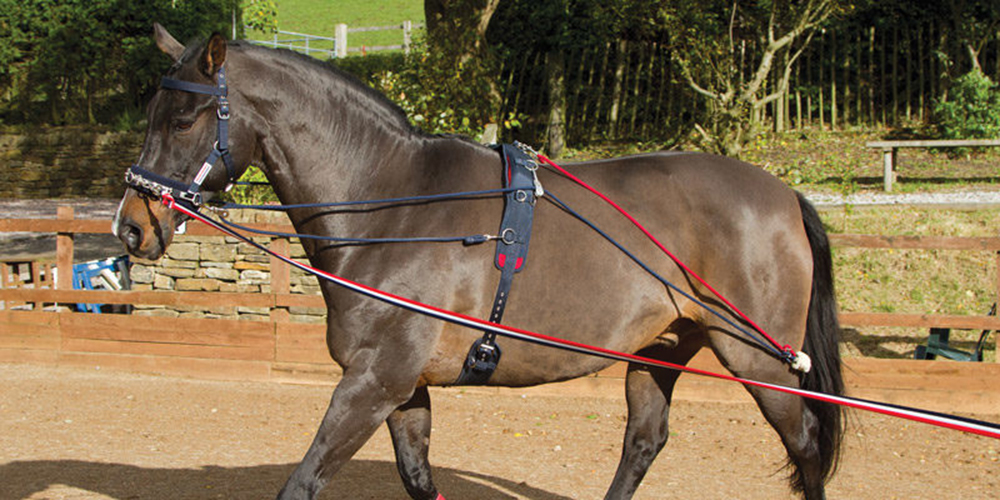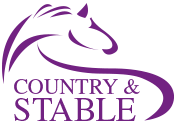Guide to Lunging a Horse
Jan 31st 2024

There are many different types of groundwork training exercises for your horse, and lunging is among the most popular for many equestrians. Lunging is where the horse is worked on a circle around you on a long line called a lunge line. It is an invaluable tool for training, exercising, and building a strong bond with your horse. Read our guide to lunging a horse to gain knowledge on equipment and best practices. If you are new to lunging, it is always advised to seek guidance from someone who is more experienced such as a professional trainer.
Why lunge your horse?
Lunging is a fundamental part of horse training. The initial use is to train a young horse, but this can then transition into further educating your horse. Lunging improves the horse’s physical condition by developing rhythm, balance, suppleness, willingness to go forward and overall fitness. It also adds variation to your horse’s workload and will help stimulate their brain.
Lunging is a great way to bring a horse back into work, help settle and relax a fresh horse prior to ridden work. You can also use lunging to teach more advanced dressage work. Not only is it a great exercise for your horse, but it can be beneficial for you as a rider. You can sit on your horse whilst they are lunged by another handler and use this time to work on your riding.
What lunge equipment do you need?
Before you start lunging, you will need to make sure you have everything you need to have a productive training session. The equipment you require will be determined by the goals you are looking to achieve. For example, if you plan to ride after lunging your equipment selection may be different to if your session is solely for lunging only.
Bridle
Firstly, you require a plain snaffle bit bridle. If you are going to ride afterwards, you can use your regular riding bridle with the reins twisted up and secured. Then either use a lunge adaptor or thread the lunge line through the bit, then pass over the head.
If you are lunging for exercise, having a separate lunge bridle can come in handy to save you time. All you require is a basic snaffle bridle, minus the noseband and reins. This can be used in conjunction with a cavesson if you are using additional training aids like side reins.
Cavesson
A cavesson looks a bit like a headcollar with a padded noseband and metal rings on the front. The lunge line attaches to the central swivel ring. This can be fitted over the bridle and secured sufficiently to avoid being pulled and slipping into the eye. The use of a cavesson means the lunge line does not need to be changed around when swapping reins. This would need to be done when threading the line over the head.

Saddle or Roller
Again, what you use here will be determined by the activity. If you are only doing a quick lunge to take the freshness off your horse and you are going to ride, then use your saddle. Alternatively, if you would like to exercise your horse with less weight, a roller is perfect for this. A roller has rings on which allow side reins or other gadgets to be attached to. To ensure optimum comfort ensure there is a pad under whichever you use.
Lunge Rein
A lunge rein is 10m (33ft) long synthetic, flat webbing rope with a swivel jointed clip at one end. The clip attaches to the cavesson with the loop handle at the other.
Lunge whip
A lunge whip has an extra-long handle with a lash long enough to reach behind the horse and acts as an aid to encourage the horse forward.
Brushing boots
Due to your horse working on a constant circle, it is important to put brushing boots on all four legs to prevent damage from knocks.
Extra lunging aids
You can use additional lunging equipment such as side reins, however, it is important that these are used correctly, and your horse is established and fit enough.
TIP: To get your side reins the right length, measure the distance from your horse’s girth or roller to behind their ears. This will help you make sure they are not too tight. Your side reins are there to mimic the rider’s contact, not to fix your horse’s head into an outline.
Once your horse is fit and capable of working in side reins you can opt to move to further gadgets such as a Chambon, bungee or training aid system. Prior to using any of these, ensure you learn how to use them correctly.
Handler Equipment
With you as the handler it is important you are wearing the correct equipment. The most important pieces of equipment are, a fitted helmet and a good pair of riding gloves. If your horse spooks or decides to take off and the lunge reins slide quickly through your hands, gloves will help prevent any rope burns. Your helmet will protect you from injury should your horse kick out or pull you over.
Before you start lunging a horse
Being able to manage the equipment in a safe manner is crucial. You must have full control of the lunge line so it can be let out and brought back in whilst carrying a whip and keeping it in position. You do not want to let the line touch the ground as you or the horse may trip up. It is recommended to practise handling your equipment without a horse first to ensure you are comfortable and confident when using them with a horse.
Practice using verbal commands with your horse by using different tones, noises, and words. The higher and quicker your voice, the faster the horse should move. The longer and lower your voice, your horse should slow down.
You need to ensure you are standing and moving correctly. By doing this you will be more efficient and reactive to control the horse should they suddenly pull or turn. Firstly, stand up straight, legs slightly apart, position your arms like you are in the saddle with a soft bent elbow. Your body language is an important aid to keep your horse in control, be positive and remain strong and relaxed. You will then need to be able to walk in a small leg crossing circle. Again, practice this movement before you begin exercising your horse.
Guide to lunge your horse
Now lets discuss how to lunge your horse
-
Choosing the area and surface
When you lunge you require an area big enough to maintain a 20m circle. This should be done on a non-slip surface which is flat as possible. Working on the lunge is much more strenuous so avoid hard surfaces or anything uneven. Depending on the level of your horse it may be beneficial to start off in either a round pen or a fenced area where it will be easier to control your horse.
-
Maintain a position
Lunging is to work your horse on a maintained circle, with you as the centre point for the horse to move around. To help assist with this, imagine you are the point of a triangle, your lunge line and whip form the two sides and you stay parallel to your horse to complete the third side. You then need to maintain this triangle position to ensure you do not get ahead or behind your horse.
-
Warm-up
Like a ridden session, it is important to start by allowing your horse to stretch down in walk and trot before working them in canter. This is also the best time to practice your voice commands before performing any faster work, to ensure your horse is listening to your voice aids and you are in full control.
-
Work equally on both reins and use transitions
It is important to work your horse equally in both directions in walk, trot, and canter. Ensure you only work to your horse’s level and fitness, do not ask for things they are not capable of. To make things easier, if your horse has a stiffer rein, it is best to start on their good rein first. This will help to loosen any tight areas and build confidence. Do lots of upward and downward transitions. Another exercise it to collect and lengthen in the paces, by doing this you will get them listening and using their hindquarters, as well as being obedient to your voice commands. This is also the time you can work with your side reins or other training aids.
-
Cool down
After the lunge session allow your horse to stretch in walk on both reins. This is also the time where you can remove or loosen your side reins. Keep them walking forwards and continue until their breathing has returned to normal.

TIP: Working a horse on the lunge is more intense than riding, so do not overdo it. Five to ten minutes equally on each rein with plenty of walk breaks is sufficient. As your horse’s fitness improves, you can increase the time.
Lunging is a great way to introduce groundwork to your horse. Once basic lunging has been mastered you can start to incorporate ground poles, raised poles, and then jumps. This can also then lead to lunging with two lines and long reining, which is another training aspect we can use with our horses.
If this blog has inspired you and you are looking for lunge equipment, check out our range here.




